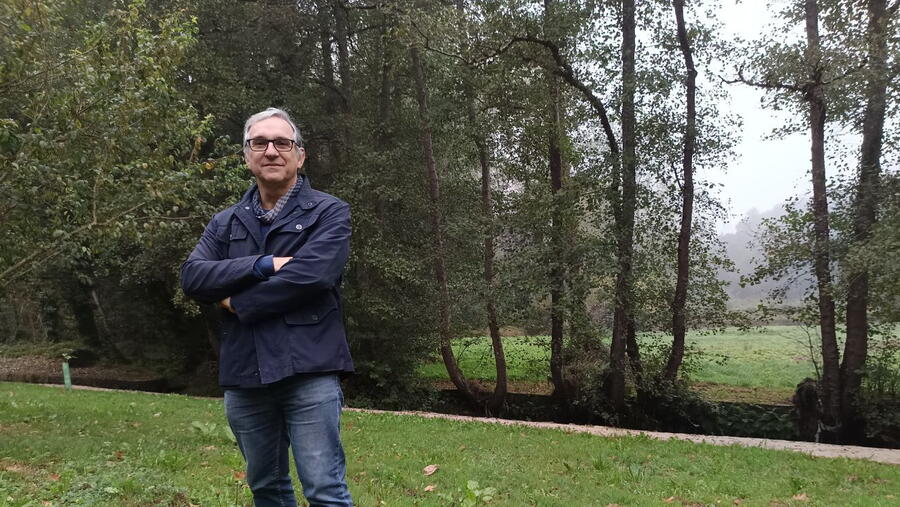Santiago Lamosa Quinteiro: «The agricultural engineer of the future will combine mud on their boots with cutting-edge technology»

Santiago Lamosa Quinteiro is a professor and researcher in the Department of Plant Production and Engineering Projects at the Higher Polytechnic School of Engineering at the USC Terra Campus, where he also serves as coordinator of the Degree in Agricultural and Agri-Food Engineering and secretary of the Department of Plant Production and Engineering Projects. With a career that combines professional experience outside the university and solid academic work, Lamosa represents a comprehensive vision of agricultural engineering: practical, innovative, and committed to sustainability.
His teaching activities cover subjects related to the environment and landscaping, areas in which he promotes training that integrates science, technology, and ecological awareness. In his research, he has addressed topics as diverse as the study of mycorrhizae and their forestry application, the development of green roofs and vertical gardens with native species, and the commercial potential of elderberry.
In addition, he maintains a strong commitment to occupational safety in agriculture and to the dissemination of science through initiatives such as Ciencia á Feira.
With this extensive background, Lamosa is committed to conveying a message of respect and responsibility towards nature to society, integrating scientific knowledge with practical action and sustainable design. In this interview, he reviews his career, the evolution of agricultural engineering, and the challenges facing new generations of professionals in a constantly changing world.
-Your career combines experience in private enterprise with a solid academic background. How did that professional stage prior to joining the university influence your teaching and research?
-Absolutely. Professional experience is perhaps the factor that most influences the approach I take in my classes. Engineering is an eminently practical profession where the theoretical basis is fundamental. The applied approach to this knowledge helps students get closer to the reality of their professional future.
On the other hand, my experience in the private sector enabled me to subsequently develop projects closer to the professional world, such as several related to workplace prevention and safety, as well as nursery plant production.
-You teach subjects related to the environment and landscaping in various undergraduate and master's degrees. How important do you think training in sustainability and landscaping is for the future of agricultural and agri-food engineering?
-Today, no one can deny that we are living in a rapidly changing world. Never in human history have so many extreme geological and landscape transformations been witnessed by a single generation. Now, a person can observe how mountains disappear, how large bodies of water form, how river courses are modified, how species disappear, or how deserts appear where once there was an abundance of plant life.
Throughout history, the role of the agricultural engineer/farmer has varied, though it has always remained essential to the production of food and other primary products and their transformation.
There were times when scientific knowledge was scarce, others when productivity took precedence over conservation, and I could go on talking about other issues that are fortunately changing, such as labor, phytosanitary products, the erosive effects of agricultural activities, water use, food security...
Returning to the question, it is obvious that an agricultural engineer, with direct responsibility for all these aspects, must be particularly sensitive to the landscape and sustainability, so that it permeates all their activities and, therefore, they must receive direct or cross-disciplinary training in this regard. This is part of our responsibility.
-As coordinator of the Degree in Agricultural and Agri-Food Engineering, what challenges and opportunities do you see in the training of new engineers in this field?
-Earlier, I spoke of the changing world related to nature, but we can also apply this to scientific, technological, and legislative advances. Agricultural engineers must undergo continuous training to address the challenges society imposes across a multitude of areas, such as technological advances, safe food production, animal welfare, and environmental conservation and regeneration.
The stereotype of the agricultural engineer with his boots on the ground is changing. Obviously, we will continue to get our shoes muddy, as this is part of our vocation. Still, now we are also receiving extensive training in the latest advances, such as robotization, the use of drones, sensors, and highly sophisticated equipment in general, which, together with advances in biochemistry, genetics, microbiology, etc., mean that agricultural engineers have a very promising future and a high level of responsibility.
-Your doctoral thesis focused on the study of mycorrhizal fungi and their application in forest species. What contributions would you highlight from that line of work, and what possibilities for transfer does it still have today?
-Mycorrhizae are highly specialized fungi that live in association with the roots of many plants, receiving mutual benefit and playing a fundamental role from an environmental point of view.
These aspects also translate into direct benefits for our activity, such as increased tree growth, greater resistance to disease, higher productivity, and reduced fertilizer use.
Studies on mycorrhizae led to a greater understanding of species collaboration, the valorization of soil as a living and sensitive ecosystem, and the integration of mycorrhizae into the routine activities of nursery production. My work focused on the third line.

-In recent years, you have worked on vertical gardens, green roofs, and the commercial potential of elderberry. How did this thematic evolution in your research come about, and what are your current objectives?
-All these lines have as a common link the study of plants and their practical application. I like to approach tasks with a tangible and functional orientation. Most of these studies were driven by companies with a clear commercial objective.
The first project arose from the increasingly frequent use of green roofs, which provide benefits such as reducing the heat island effect, improving thermal insulation, retaining rainwater, and promoting urban biodiversity. At that time, they were interested in studying the possibility of using native Galician species. As a natural evolution, the line of vertical gardens emerged, also linked to a company that studied the use of different plant species, substrates, irrigation, support structures, etc.
The study on elderberry faced an added challenge: it was the first in Galicia to examine its commercial use. The results were very promising, and there was some interest from entrepreneurs, which led to the creation of some plantations. In this sense, there is still much to be done.
-You have also collaborated in the development of landscaping projects with a focus on sustainable gardens, permaculture, and regenerative agriculture. What role do these practices play in the transition to more environmentally friendly models?
-If we look at the history of gardens, we see how they responded to the thinking, concerns, or needs of each era. Today, in the world we live in, we cannot conceive of a garden purely as an aesthetic or functional entity without taking into account its ecological, ethical, and social values.
Permaculture offers a compelling vision for creating sustainable, productive gardens in harmony with nature. These are spaces that aim to mimic the patterns and relationships of natural ecosystems, integrating a wide range of natural elements without forgetting the use of local resources and the care for the land and people.
I believe that these gardens should be conceived as models and learning centers to expand respect for nature.
Regenerative agriculture is a response to the term sustainability, since there are many contexts in which a simple sustainable intervention is insufficient. Applying these philosophies to gardening is a significant challenge, as it challenges the traditional view we have of gardening.
-In the past, you have also researched safety in agriculture, landscaping, and children's play areas. What are the main challenges for improving risk prevention in these contexts?
-Since the first safety studies of playgrounds, they have evolved favorably and, above all, have become widespread in practically all play areas. Currently, most children's playgrounds comply with European regulations UNE-EN 1176 and 1177, although they may fall short in maintenance and renovation.
In my opinion, it is not enough to simply comply with the standard, and this is where one of the major challenges arises: building playgrounds that are truly attractive to children, not only based on play equipment but also combined with beautiful designs featuring plants, landscaping, and routes that seek to create opportunities for children's personal and social development in a space that is close to nature and safe.
Another challenge, perhaps unknown, is the use of 100% safe materials. Today, there is sufficient scientific literature to suggest the possible toxicity of certain materials commonly used in playgrounds, such as synthetic materials from poor-quality or unregulated sources, including recycled tires. This is not a line of research of mine, but it is of great interest as it directly affects the safe design of children's playgrounds.
-Through initiatives such as Ciencia á Feira, you took your research beyond the classroom. What does outreach bring to your work as a teacher and researcher?
-With Ciencia á Feira, I collaborated by giving talks on ectomycorrhizae to audiences of all ages, but mainly to children. I could see the enthusiasm of the children and adults when I told them about things they found extraordinary, and for me, commonplace.
Seeing those faces of amazement, I felt I was planting a seed that would germinate and, in turn, bear new fruit. I like to think it was a seed of curiosity and a love of nature. I also want to convey this implicitly in my university classes.
-What are the projects or lines of work you would like to develop in the coming years within Campus Terra?
-Among the lines of work in recent years, I see the study of elderberry as very promising, specifically the selection of varieties of commercial interest and the profiling of their production process, as well as the possible commercial use of other native species with no apparent economic interest.
I am also increasingly interested in what we at the university can convey to society, not only in tangible terms or scientific knowledge, but also in universal principles of respect and responsibility towards nature. That is why I am increasingly involved in sustainable and regenerative projects and, by transferring this to my field, in their applicability to the design of green areas.
